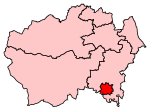Darlington

Darlington is a market and industrial town in County Durham, England. It is the main administrative centre of the unitary authority Borough of Darlington. The borough is a constituent member of the devolved Tees Valley area.A tributary of the River Tees, to the south of the town, known as the River Skerne flows through the town. The town is near the Yorkshire Dales National Park, being 11 miles (18 km) from the park boundary near the town of Richmond. The town had a population of 93,015 in the 2021 Census, classed as large.In the 19th century, establishment of the Stockton and Darlington Railway (the world's first permanent steam locomotive powered passenger railway) led to the town having an industrial and manufacturing economy.
Excerpt from the Wikipedia article Darlington (License: CC BY-SA 3.0, Authors, Images).Darlington
East Street,
Geographical coordinates (GPS) Address Nearby Places Show on map
Geographical coordinates (GPS)
| Latitude | Longitude |
|---|---|
| N 54.527 ° | E -1.5526 ° |
Address
East Street Multi-Storey
East Street
DL1 1PN , Bank Top
England, United Kingdom
Open on Google Maps








